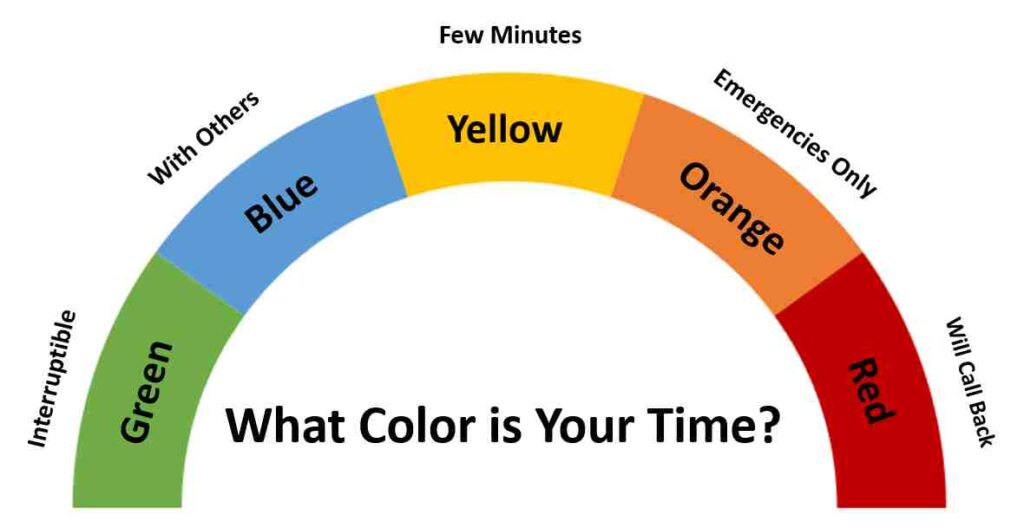One of the cool things about working with motivated mentees is that they curate wisdom from a bunch of sources, and often as their mentor, you become exposed to a new and exciting concept they discovered. This recently happened to me with one of my clients Gregg “3G” Sheldon, founder and CEO of AutoShop Vocational. He was looking for some business advice and before asking his question, he asked, “What color is your time?” Having never heard this before, I was intrigued and since I had some free time on my calendar, I agreed to speak to him.
The life of a business owner is, by nature, often very reactive. Owners are forced to deal with problems as they arise, resulting in days that feel like they have accomplished nothing. As small business owners, we also have critical projects and deadlines that we have to manage each day. A day filled with a constant stream of interruptions results in increased levels of stress and the feeling of not being in control. Sound familiar? It sure does to me.
I do some of my best work on the weekends when there are fewer interruptions because I can enter a State of Flow with no distractions. In fact, as I write this, it is a Sunday afternoon, and my wife is off shopping, so it is just me and my German Shepherd, Luger.
Interruptions are a killer for maintaining a State of Flow. While many entrepreneurs say they are great at multitasking, it is a myth. The human brain cannot perform two tasks that require high-level brain function at once. While I may be able to drive a car and listen to an audiobook, listening to an audiobook or the radio while driving is not multitasking two high-level tasks.
According to Amos Tversky and Daniel Kahneman in their book Thinking Fast and Slow, we have two brain systems. System-1 is the reactive and automatic or fast thinking part of the human brain. System-2 is the logical and thoughtful, but resource-intensive and slow thinking part of the brain. To achieve a State of Flow necessary to accomplish most projects, we use our system-2 brain and we can’t afford to be multitasking. What actually happens when we think we are multitasking is that we are just switching from one task to another.
Gloria Mark, a professor in the department of informatics at the University of California, Irvine, says that when people are interrupted, it typically takes 23 minutes and 15 seconds to return to their work. She adds that most people when interrupted will do two intervening tasks before going back to their original project.
In an office setting, you can close your door and signal to your co-workers that interruptions are not welcome because your System-2 brain is engaged and you are in a State of Flow. But what if you are working from home or out of the office and engaged in something very important, how can you tell your co-workers that interruptions are either welcome or not?
In the old days, if you needed to talk with someone, you simply walked to their office to see if the door was open or closed. However, today, more and more people are working from home. Back in the day, you also only had an office phone and if you were in a meeting or away from your desk, you were pretty much unreachable. Today, however, everyone has a mobile device. Nobody thinks twice about dialing your mobile or texting you at the drop of a hat. Few rules of etiquette exist concerning the use of cell phones today and they represent the number one source of interruptions to a person’s State of Flow.
Leil Lowndes is an internationally recognized communications expert who specializes in the subconscious interactions that take place in interpersonal communications. She suggests that perhaps there may be a way to convey your ability to accept an interruption. In her book How to Talk to Anyone, she talks about a communication technique that begins with asking the other person “What color is your time?” before interrupting them. Asking a person about the color of their time is a respectful way of asking “Is this a good time for you to talk?”
While Leil used only three colors, I recommend the adoption of five colors to convey to others what is the color of your time. I added two additional colors that I borrowed from the Covid restrictions dial we used in Colorado.
Green – Interruptible
When you respond with your color Green, you are saying that “I’m not engaged in anything really important right now. I have time to talk to you now.”
Blue – With Others
When you respond with your color Blue, you are saying “I’m not really busy but I’m with others. I might not be able to give you 100% of my attention. Feel free to talk to me if you need something from me immediately or I can call you back later when I’m alone and have more time to give you my undivided attention.”
Yellow – Few Minutes
When you respond with your color Yellow, you are saying “I have something that I do need to get done but I have some slack time, so I can spare a few minutes to speak to you.”
Orange – Emergencies Only
When you respond with your color Orange, you are saying, “I’m in the middle of something really important. Unless this is an emergency, I’d like to talk later.”
Red – Will Call Back Later
When you respond with your color Red, you are saying “I have no time to talk now. I’m completely engrossed in a project. I’ll need to call you back later.”
So, to improve office productivity and to be sensitive to the other person’s time, the first words I use in text messages to see if they are available for a meeting or when I call a person’s mobile device to talk, are “What color is your time?”
How can you implement a color code to let others know what color is your time?












